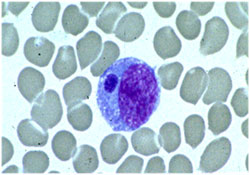Ehrlichiosis causes
Jump to navigation
Jump to search
|
Ehrlichiosis Microchapters |
|
Diagnosis |
|---|
|
Treatment |
|
Case Studies |
|
Ehrlichiosis causes On the Web |
|
American Roentgen Ray Society Images of Ehrlichiosis causes |
| Ehrlichiae | ||||||||||||||
|---|---|---|---|---|---|---|---|---|---|---|---|---|---|---|
 | ||||||||||||||
| Scientific classification | ||||||||||||||
|
Editor-In-Chief: C. Michael Gibson, M.S., M.D. [1] Associate Editor(s)-in-Chief: Ilan Dock, B.S.
Overview
Ehrlichiosis is a tickborne[1] bacterial infection,[2] caused by bacteria of the family Anaplasmataceae, genera Ehrlichia and Anaplasma. These obligate intracellular bacteria infect and kill the white blood cells. Ehrlichiae are transmitted to humans by the bite of an infected tick. Usually, symptoms occur within 1-2 weeks following a tick bite. [3]
Taxonomy
| Classifications[4] [5] | |
|---|---|
| Domain | Bacteria |
| Kingdom | Prokaryote |
| Phylum | Proteobacteria |
| Class | Alpha Protobacteria |
| Order | Rickettsiales |
| Family | Anaplasmataceae |
| Genus | Ehrlichia |
| Species |
|
Phylogeny
- Small intracellular bacteria
- Infect vacuoles of host eukaryotic cells
- Gram-negative cell wall
- Grow within a host cells endosomes in morulae clusters
- Manipulate the endosomes mechanical function in order to resist lysosomal fusion
- Ehrlichiae exits the cell as morulae attaches to cell wall
- Target cells include neutrophils, platelets, erythrocytes, and endothelium
General Tick Life Cycle

- A tick's life cycle is composed of four stages: hatching (egg), nymph (six legged), nymph (eight legged), and an adult.
- Ticks require blood meal to survive through their life cycle.
- Hosts for tick blood meals include mammals, birds, reptiles, and amphibians. Ticks will most likely transfer between different hosts during the different stages of their life cycle.
- Humans are most often targeted during the nymph and adult stages of the life cycle.
- Life cycle is also dependent on seasonal variation.
- Ticks will go from eggs to larva during the summer months, infecting bird or rodent host during the larval stage.
- Larva will infect the host from the summer until the following spring, at which point they will progress into the nymph stage.
- During the nymph stage, a tick will most likely seek a mammal host (including humans).
- A nymph will remain with the selected host until the following fall at which point it will progress into an adult.
- As an adult, a tick will feed on a mammalian host. However unlike previous stages, ticks will prefer larger mammals over rodents.
- The average tick life cycle requires three years for completion.
- Different species will undergo certain variations within their individual life cycles.
Transmission
- Ehrlichia are transported between cells through the host cell filopodia during initial stages of infection, whereas, in the final stages of infection the pathogen ruptures the host cell membrane.[7]
- Most of the symptoms of ehrlichiosis can likely be ascribed to the immune dysfunction that it causes.
- Early in infection, production of TNF-alpha, a cellular product that promotes inflammation and immune response, is suppressed.
- Experiments in mouse models further supports this hypothesis, as mice lacking TNF-alpha I/II receptors are resistant to liver injury caused by ehrlichia infection.
- Late in infection, however, production of this substance can be upregulated by 30 fold, which is likely responsible for the "toxic shock-like" syndrome seen in some severe cases of ehrlichiosis.[8]
References
- ↑ CDC "Questions and Answers" page for tickborne rickettsial diseases
- ↑ Dawson, Jacqueline E., Marty, Aileen M. (1997). "Ehrlichiosis". In Horsburgh CR, Nelson AM. Pathology of emerging Infections. 1. American Society for Microbiology.
- ↑ CDC Ehrlichiosis main information page
- ↑ The Cause of Rocky Mountain Spotted Fever. Rickettsia Ricketsii. http://bioweb.uwlax.edu/bio203/s2008/gibson_chel/Classification.htm Accessed January 11, 2016.
- ↑ Dantas-Torres, Filipe. Lancet Infect Disease 2007;7:724-32. Department of Immunology, Center of Research Aggeu Magalhaes, Oswaldo Cruz Foundation. Recife Pernambuco, Brazil. Volume 7, November 2007. Accessed on January 11, 2016
- ↑ Life Cycle of Ticks that Bite Humans (2015). http://www.cdc.gov/ticks/life_cycle_and_hosts.html Accessed on December 30, 2015
- ↑ Thomas S, Popov VL, Walker DH (2010). Kaushal, Deepak, ed. "Exit Mechanisms of the Intracellular Bacterium Ehrlichia". PLoS ONE. 5 (12): e15775. doi:10.1371/journal.pone.0015775. PMC 3004962. PMID 21187937.
- ↑ McBride, Jere W. (31 January 2011). "Molecular and cellular pathobiology of Ehrlichia infection: targets for new therapeutics and immunomodulation strategies". Expert Reviews in Molecular Medicine. 13. doi:10.1017/S1462399410001730. Unknown parameter
|coauthors=ignored (help)